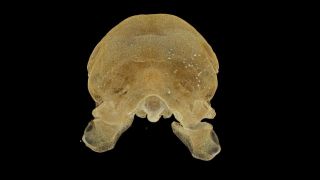'Alice in Wonderland' Dodo Was Murdered in Cold Blood
Dodos went extinct more than 300 years ago, but scientists are only now opening up a cold case after learning that one of the birds — the prized dodo specimen that likely inspired author Lewis Carroll to create a dodo character in the 1865 book "Alice in Wonderland" — was brutally murdered.
After recently loading the famous dodo into a micro-computed tomography (micro-CT) scanner, researchers noticed that the scans showed weird fleck marks in the flightless bird's neck and the back of its head.
A closer inspection revealed that those flecks were tiny lead pellets, meaning that someone shot the dodo from behind, killing the wildfowl, the researchers announced Friday (April 20). [In Photos: The Famous Flightless Dodo]
The murderous finding came as a complete surprise, said Paul Smith, the director of the Oxford University Museum of Natural History in England, where the dodo specimen — called the Oxford dodo — is on display. For years, curators thought that the specimen was the same bird that was brought to London in 1638, when the animal was still alive, Smith said. This famous dodo was a curiosity show, and people could pay to see and feed it.

It was thought that the curiosity-show dodo died and the remains of its body was later acquired by John Tradescant the Elder, whose family provided the founding collection for the University of Oxford museums. But the great performing dodo was never shot (at least that we know of), which raises the question: Where did the Oxford dodo come from if it's not the same one that performed in the London curiosity show so many years ago?
"There is now a mystery regarding how the specimen came to be in Tradescant's collection," Smith told Live Science. The even greater mystery is, "Who killed the dodo?" Smith said.
Dodos (Raphus cucullatus) were native to Mauritius, an island east of Madagascar in the Indian Ocean. Europeans first took notice of the bird when Dutch explorers found the animals in 1598. But after decades of hungry sailors eating the birds, habitat loss and invasive rats, cats, dogs and pigs eating their eggs, dodos went extinct on their native island in 1662.
Sign up for the Live Science daily newsletter now
Get the world’s most fascinating discoveries delivered straight to your inbox.
The Oxford dodo is the only specimen in the world that still contains skin and other soft tissues with extractable DNA. In a 2002 study published in the journal Science, researchers examined this dodo's DNA and found that the bird is, indeed, a giant flightless pigeon whose closest living relative is the Nicobar pigeon.
Researchers decided to study the Oxford dodo specimen again so they could get a better idea of how dodos fed and what they ate, Smith said. So, Oxford researchers coordinated with scientists at the University of Warwick's Warwick Manufacturing Group (WMG) in England, where the bird was micro-CT scanned.

Curiously, the lead shot didn't penetrate the dodo's thick skull, the scans revealed. But these shots still killed the bird, the researchers said.
"This is a flightless bird, so obviously, somebody snuck up behind the poor thing and just shot it in the head," said Mark Williams, leader of the Product Evaluation Technologies and Metrology research groups at WMG, University of Warwick, who is studying the Oxford dodo.
Now that the cold case is open, the researchers plan to analyze the lead shot to see where it was mined.
"At the moment, we don't know where the bird was actually shot," Williams told Live Science. "Was it shot in the U.K.? More likely, was it shot in the Mauritius and then transferred to the U.K.? Was it shot for food on a ship? We really don't know."
Original article on Live Science.

Laura is the archaeology and Life's Little Mysteries editor at Live Science. She also reports on general science, including paleontology. Her work has appeared in The New York Times, Scholastic, Popular Science and Spectrum, a site on autism research. She has won multiple awards from the Society of Professional Journalists and the Washington Newspaper Publishers Association for her reporting at a weekly newspaper near Seattle. Laura holds a bachelor's degree in English literature and psychology from Washington University in St. Louis and a master's degree in science writing from NYU.

